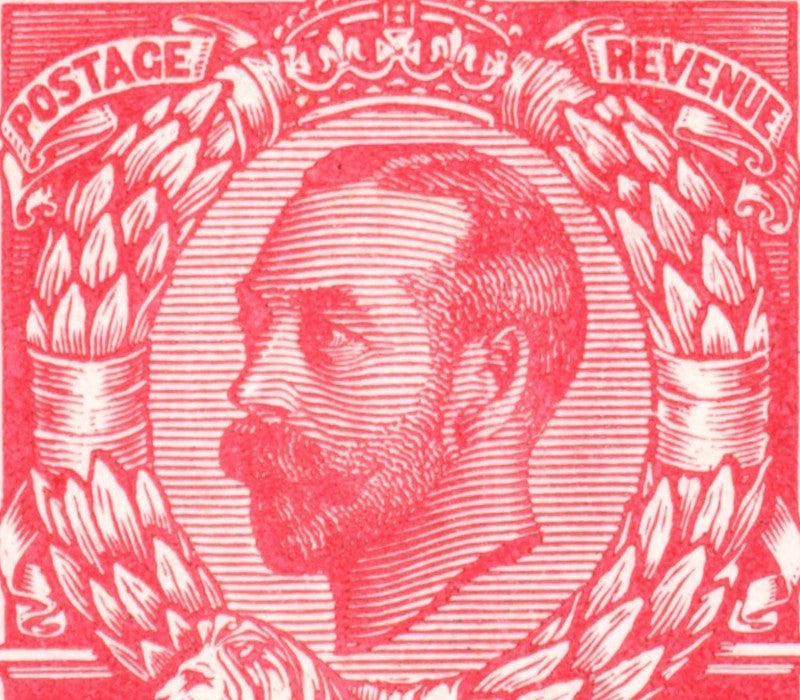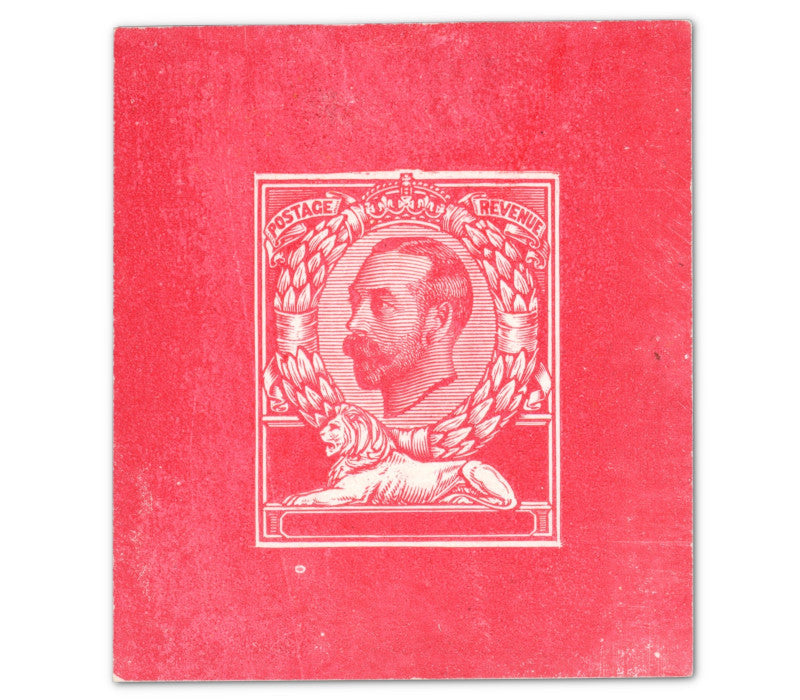Today's item is a noble failure.
It's also rare, bold, eye-catching and unusual.
But a failure none the less.
That's what makes it so fascinating.
It's a piece of British philatelic history with a superb pedigree.
I'd consider it as a 'must have' item for specialised collectors.
And it proves the idea that, as collectors, we love it when something goes wrong. The errors, the blunders, and the unpopular designs that were quickly consigned to the waste bin of history.
That's often where we find our favourite treasures.
And certainly the pieces with the most interesting stories.
This is one of them.

It's a rare die proof for the Great Britain 1911 1d 'Downey Head" issue.
The first postage stamp featuring King George V.
Taken from the original Plate 1, with "POSTAGE" and "REVENUE" added in stage 2 of the design process.
This is a very fine uncleared example, printed in pale rose red on white proof paper measuring 36mm by 40mm.
And as you can see, it's a striking piece. Just picture this item displayed on a fresh page in your album.
The design certainly caught the eye of the public when the stamps were first issued in 1911.
But unfortunately, they didn't like what they saw.
A brief history of a bad idea.
 When George V ascended the throne in 1910, the nation needed new stamps.
When George V ascended the throne in 1910, the nation needed new stamps.And given that George was a passionate collector, and former President of the Royal Philatelic Society, they were under closer scrutiny than ever.
So the call went out to artists from The Royal Mint, Waterlow, Perkins/Bacon, and De La Rue, to submit their designs.
The winning entry was the joint work of Bertram Mackennal and G.W. Eve – and it was certainly a bold choice.
Instead of a traditional flat profile portrait of the King, it featured a more unusual 3/4 profile by the Royal photographers W. & D. Downey.
The design was then passed to John A.C Harrison, a respected engraver given his first stamp commission by the Royal Mint.
Harrison later went on to become of of the most celebrated engravers in the philatelic world, and produced the iconic 1913 Seahorse stamps.
(Today the majority of Harrison's original British and British Commonwealth die proofs are housed in the British Library Philatelic Collection.)
But at some point the process began to fall apart.
The plates were produced by the Royal Mint, which had never made postage stamp plates.
And the stamps were printed by Harrison & Sons, who had never previously printed postage stamps.
There were further delays which meant that only two values were ready in time: the ½d. Green 'Dolphins' design, and the 1d. Red 'Lion' design.
And then came the moment of truth...
The Royal seal of disapproval.

George V was crowned on June 22, 1911, and his first stamps were issued the same day. It was a time of celebration for the entire nation...
Apart from stamp collectors.
Because they hated the King's new stamps.
And as it soon turned out, so did the public.
Every aspect was criticised, from the overall design to the quality of the printing. Nobody involved in the process escaped judgement.
In a July 1911 issue of the Stanley Gibbons Monthly Journal gave their verdict – and it wasn't good news.
"We regret to say, we greatly regret to say it, that we cannot refrain from joining in the chorus of disapproval and disappointment with which the new stamps have been greeted on every side."
It seemed the bold decision to use a 3/4 profile portrait of the King had backfired spectacularly.
The poor execution of the design only made matters worse.
And perhaps most significantly, George himself was known to dislike the stamp - which was a major problem, as it had his face on it.
The scrawny lion.

But it wasn't just the Royal portrait which came under criticism.
People also disliked the lion as well.
The lion in Harrison's original Die 1 engraving is sparsely shaded, particularly on the leg and body, with large areas that remain completely white.
Some argued that this made the lion look unhealthy, underfed and skinny around the ribs in particular.
And as the beast was supposed to represent a symbol of British strength, that simply wouldn't do!
So the Die 2 engraving was altered to include more shading, in an attempt to make it look more powerful and vigorous.
But ultimately, none of the improvements were enough to satisfy the critics.
Further denominations of the stamp were cancelled.
And in 1913 it was replaced by the Mackennal 'Profile Head' issue, featuring a more traditional portrait of the King.
In all, the Downey Head issues lasted less than two years.
But the desperate attempts to improve the design and the quality of the stamps produced a wide variety of types, shades and plateflaws.
Today their short-lived controversial history, unusual design, and numerous variations have made them a rich area for study.
And for collectors who specialise in the Downey Head issues, this rare, early Plate 1 die proof is a hugely desirable item.
Own this striking display piece today.
 The public may have hated the Downey Head stamps back in 1911.
The public may have hated the Downey Head stamps back in 1911.But this noble philatelic failure has become much-loved by collectors.
And I think this Plate 1 die proof highlights the design spectacularly.
It's an item I'd happily show off in my own collection.
The bold colour and unusual portrait give it a real eye appeal.
And the scarcity of such die proofs make it highly collectible.
I've seen similar items soar past their estimates when two specialist collectors go head to head in an auction room. Which is always something to consider.
It also represents the earliest stamp of the renowned engraver John Harrison, whose work is treasured by philatelists around the world.
And it beautifully depicts George V – perhaps the most important collector in British philatelic history.
If you're assembling a collection of George V stamps, or seeking unusual pieces for a wider GB or Commonwealth collection, this is a great item.
And if you specialise in the Downey Head issues, it's essential.
The current catalogue price for this scarce proof is £4,750.
But I can offer it to you today for £4,500.
You have 3 simple and secure ways to place your order.
- Click the link below to buy online
- Email info@paulfrasercollectibles.com
- Or call us on +44 (0) 1534 639 998
Click here to purchase now
Our guarantee to you.
This stamp comes with our Lifetime Guarantee of Authenticity, so you can add it to your collection with complete peace of mind for the future.
Delivery is completely free and fully insured.
And it's also covered with our 28-day money back guarantee if you change your mind for any reason.
If you have any further questions on this stamp, get in touch today and we'll be happy to help.
Thanks for reading,
Owen.
Paul Fraser Collectibles.






